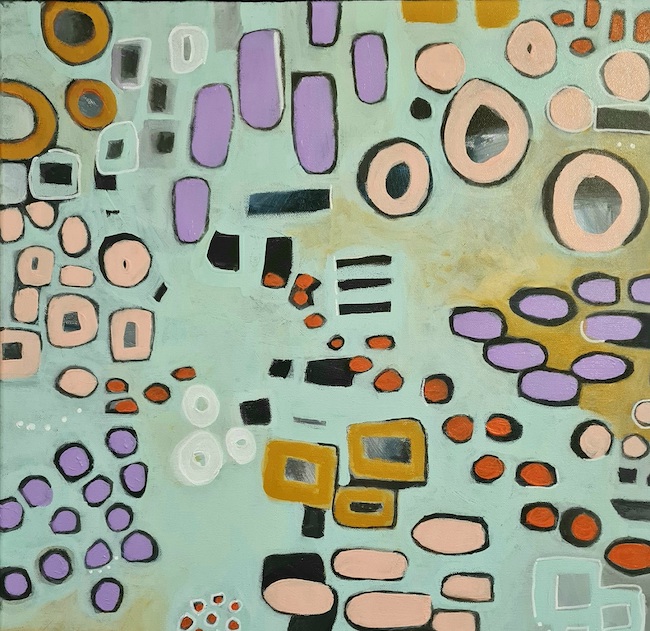Il viaggio, lo spostamento, rappresenta una realtà attuale funzionale ad aprirsi all’ascolto e ad accrescere le proprie conoscenze esterne ma anche quelle rivolte a se stessi, in particolar modo per la sensibilità e l’attitudine all’osservazione del mondo circostante che appartengono agli artisti; la scoperta di modi nuovi di affrontare le cose, di punti di vista spesso opposti al proprio eppure ugualmente veri, induce la personalità creativa a mettersi in discussione e cercare costantemente nuove strade per evolvere e continuare a esplorare se stessi, oltre che il proprio approccio stilistico ed espressivo. La protagonista di oggi ha fatto del viaggio il tema principale della sua vita ed è grazie alle differenze dei molti paesi che l’hanno ospitata che ha potuto elaborare uno stile in cui mescola le caratteristiche e le emozioni che di ciascuno di essi si è portata via con sé.
Il cammino artistico di molti grandi maestri del Novecento, si è formato, delineato e sviluppato in virtù delle possibilità di spostamento che grazie al progresso tecnologico di quei vivaci anni si stava generando, e questo sia all’interno del territorio europeo che nei continenti limitrofi, come l’Africa, o i più lontani come l’Oriente e le Americhe. Già nei salotti di Francia gli artisti si incontravano, discutevano, prendevano spunto gli uni dagli altri e spesso si scontravano per difendere le linee guida dei movimenti a cui appartenevano o per farne nascere di nuove, ma con la diminuzione dei tempi di percorrenza della navigazione e con lo sviluppo della velocità dei treni le terre di scoperta divenivano più facilmente accessibili e dunque fonti di spunti inediti e affascinanti. Il Cubismo di Pablo Picasso fu influenzato dalle maschere tribali delle popolazioni dell’Africa tanto quanto lo fu l’Espressionismo di Amedeo Modigliani, le cui donne con i lunghi colli e l’espressione impenetrabile rappresentavano una rielaborazione dei volti lignei delle tribù indigene; e ancora l’Espressionismo di Paul Gauguin divenne grande e immortale nel tempo grazie alla scelta dell’artista di narrare atmosfere e i luoghi incantati della Polinesia, dove scelse addirittura di trasferirsi per continuare a respirare i ritmi lenti e il contatto con la natura incontaminato. Allo stesso modo un altro grande esponente dell’Espressionismo, Emil Nolde, si lasciò affascinare dall’esotismo dei popoli della Nuova Guinea al punto di modificare il suo stile pittorico inserendo elementi di quei paesi lontani evidenziando il legame primordiale tra natura e uomo. E poi vi fu tutto il patrimonio artistico e culturale dei fuggitivi, quelli che a causa delle guerre lasciarono i loro paesi di origine per sfuggire alle persecuzioni razziali, ideologiche o per cercare condizioni di vita migliori e che contaminarono il proprio linguaggio espressivo originario con caratteristiche, emozioni, sensazioni dei paesi che li ospitavano dando vita a nuovi punti di vista e innovazioni creative; Marc Chagall, russo ebreo fuggito in Francia, Arshile Gorky, grande esponente dell’Espressionismo Astratto, scappato dall’Armenia e dalle persecuzioni sul suo popolo da parte dell’esercito ottomano durante la prima guerra mondiale, e ancora l’espressionista austriaco di origine ceca Oskar Kokoshka che non solo viaggiò a lungo in Europa e in Africa ma a seguito dello scoppio della seconda guerra mondiale si rifugiò a Londra trasformando il suo stile in un sunto e una testimonianza emotiva del suo percorso di vita. A partire dalla metà degli anni Cinquanta gli spostamenti sono diventati più agevoli tanto quanto la possibilità per gli artisti di lasciarsi affascinare e influenzare da culture diverse, da approcci espressivi differenti ma anche da tutto ciò che i loro occhi vedono e percepiscono, divenendo scrigno della memoria che poi si manifesta sulla tela. È questo il caso dell’artista di origine italiana Antonella Quacchia, le cui vicissitudini di vita l’hanno condotta a vivere per i primi anni della sua vita in Brasile, a San Paolo, poi in Italia, e ancora a Ginevra, in Francia e infine a Vienna; va da sé che questa molteplicità di paesi, molto diversi tra loro per tradizioni e visione dell’esistenza, abbiano profondamente influenzato il suo modo di fare arte, soprattutto nella poliedricità che contraddistingue la sua produzione.
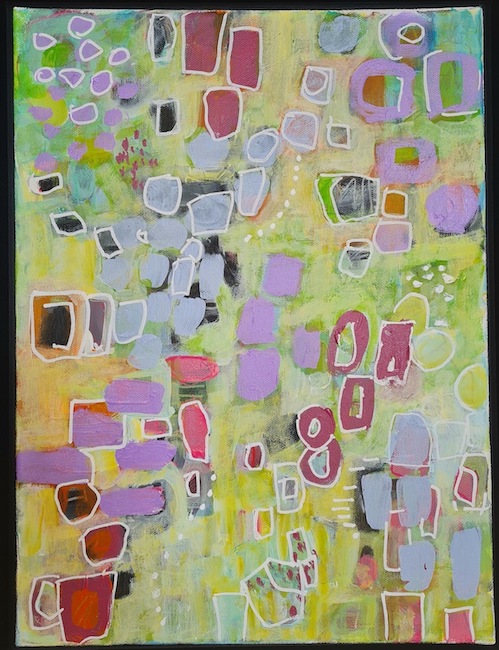
Infatti pur scegliendo il mondo della non forma, dell’indefinito, il suo stile passa da un Astrattismo vicino al tardo Kandinsky a tratti avvicinabile anche al Cubismo Orfico e all’Art Nouveau di Gustav Klimt, a un Espressionismo Astratto in cui la concretezza delle tonalità terrose si associa alla leggerezza delle nuvole bianche per esaltare il contrasto tra sogno e realità, tra consapevolezza dei limiti della contingenza e desiderio di evadere facendosi cullare dall’apertura alle possibilità; infine un terzo approccio la avvicina all’arte segnica, quella del tardo Mirò, pur mantenendo una tavolozza di colori completamente personale.
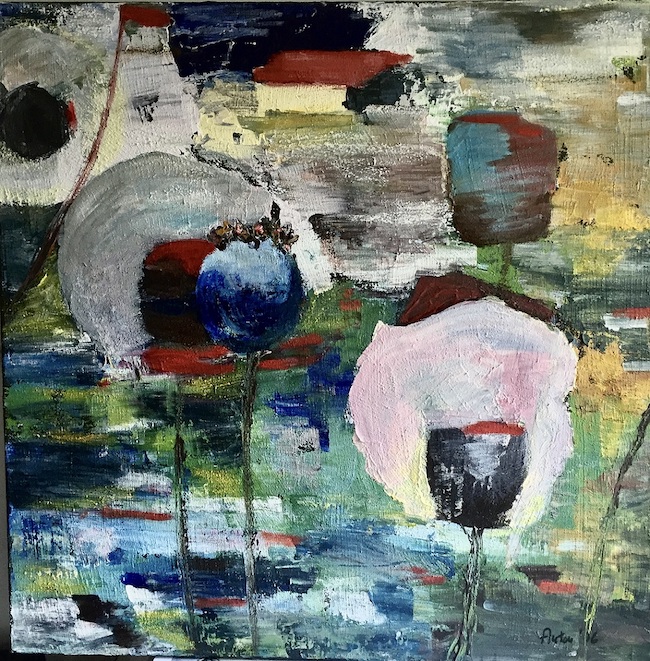
L’attitudine alla sperimentazione e alla contaminazione di Antonella Quacchia, così come la sua impossibilità a sentirsi legata a un solo stile espressivo, provengono dalla naturale inclinazione al viaggio, al lasciar vagare il suo sguardo sulla realtà circostante assorbendo e respirandone l’atmosfera e ciò che la sua interiorità ne riceve fino al punto di dover imprimere quelle sensazioni sulla tela, in maniera impalpabile e indefinibile tanto quanto lo è il mondo delle emozioni; ecco dunque il motivo della scelta di distaccarsi dall’osservato, perché non è possibile dare una forma concreta a ciò che semplicemente deve essere raccontato in maniera libera, lasciato fluire istintivamente fino a incontrare la superficie in cui si manifesta attraverso i colori e le sfumature.
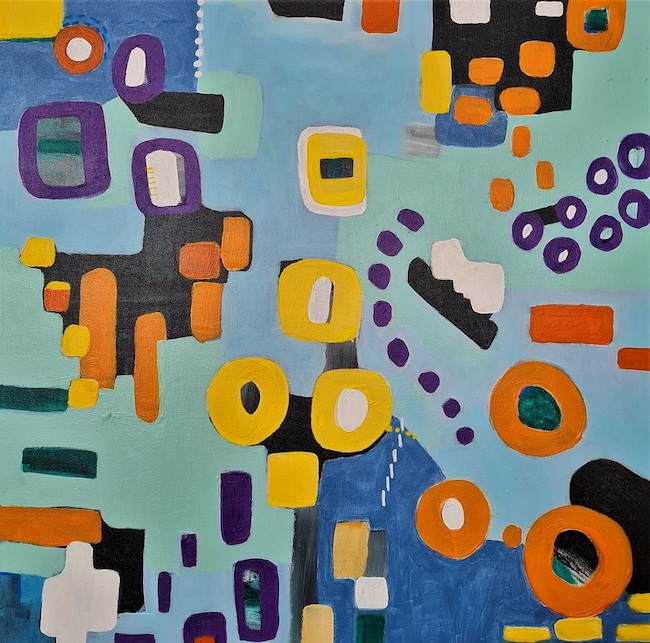
La serie Amo la vita è fortemente legata al periodo vissuto a San Paolo, e dunque la gamma cromatica è affine al mondo variopinto del Brasile così come le figure geometriche protagoniste delle tele sembrano letteralmente danzare, accordandosi all’allegria che contraddistingue il popolo paulista; osservando l’opera Amo la vita 5 sembra di trovarsi davanti all’entusiasmo tipico di chi ha compreso se stesso ma anche il segreto dell’esistenza, quello cioè di approfittare di ogni momento vivendolo con positività, con il sorriso e l’accoglienza delle emozioni piacevoli mettendo da parte quelle più ombrose che, tutto sommato, sono sempre passeggere.
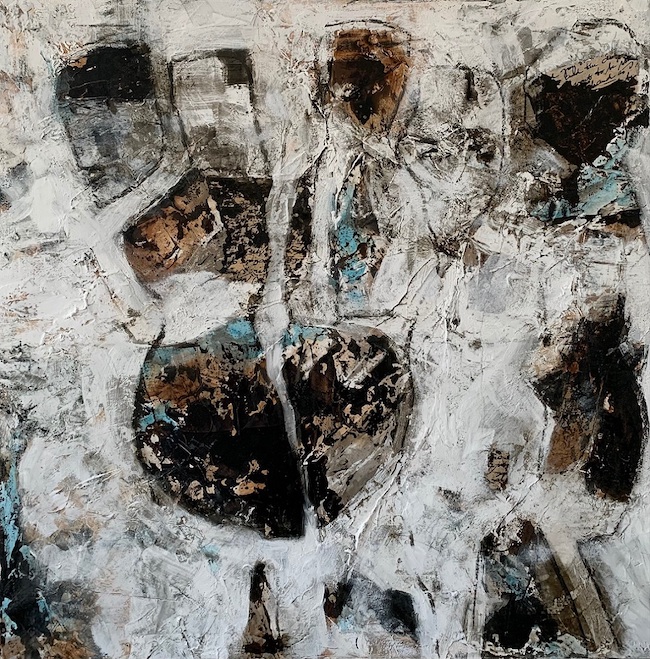
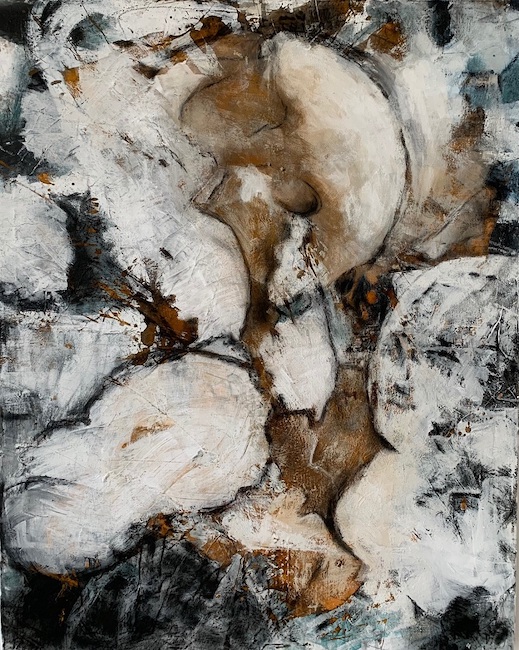
La serie Floating forms invece sembra essere più introspettiva, più orientata ad ascoltare l’eco interiore che si apre anche alla malinconia, alla nostalgia, alla consapevolezza di dover a volte percorrere un cammino all’interno della nebulosità per essere in grado di tornare a vedere il sole; in queste opere dunque, come Friends (Amici) e Dream in white (Sogno in bianco), la Quacchia oppone lo sfondo serio e scuro, contraddistinto da grigi o da marroni, al chiarore del bianco come se esso e le forme che lo avvolgono costituissero quel sogno, quel desiderio al quale aggrapparsi per ritrovare il contatto con la luce.
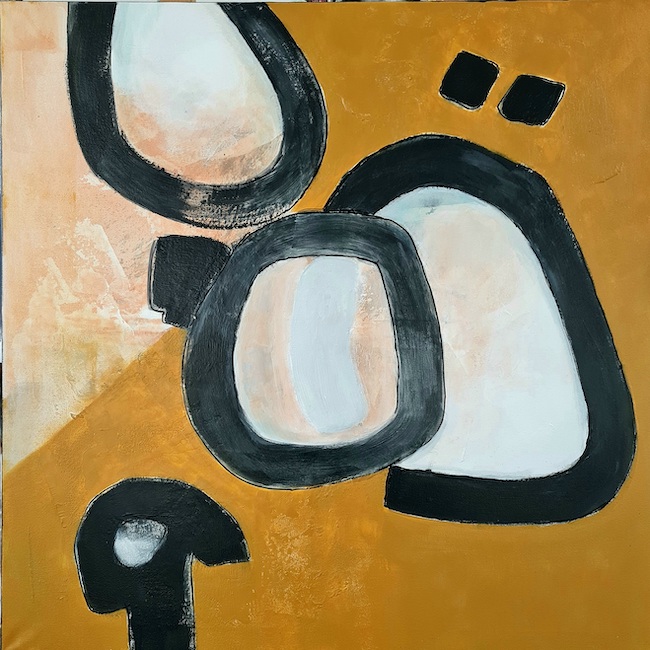
Il contorno nero sembra in qualche modo essere un contenimento, un’autolimitazione che troppo spesso le persone pongono tra sé e la possibilità di realizzare ciò che a volte osano solo sperare. La medesima linea scura diviene invece protagonista dell’opera Verliebt, verlobt, verheiratet (Innamorati, fidanzati, sposati) della serie Thematic, in cui non costituisce più una demarcazione tra ciò che si desidera e la capacità di renderlo possibile bensì diviene la rappresentazione di una realtà diversa, appartenente al mondo fanciullesco, quasi fosse un’esortazione a non trascurare la capacità di guardare il mondo con semplicità, la medesima che contraddistingue i bambini, grazie alla quale ogni cosa perde il suo aspetto serioso e si trasforma in spunto di gioco.
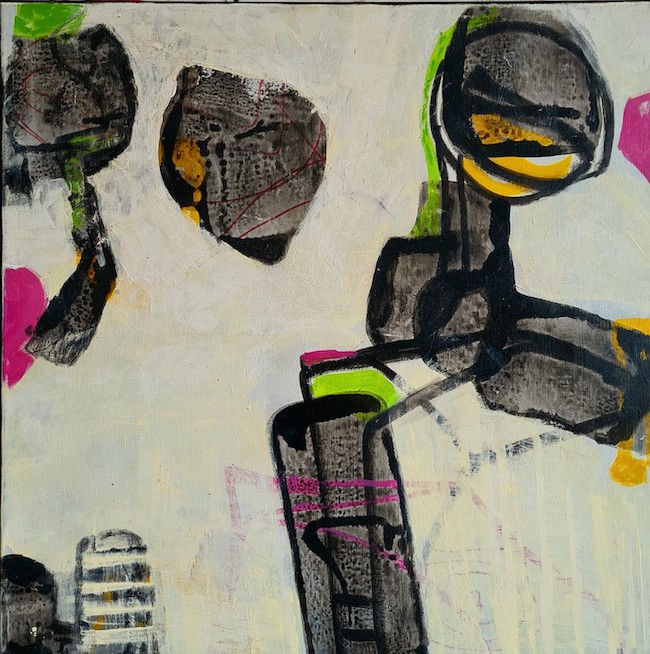
Il medesimo tema si ripete anche nella tela The boy with the Handy (Il ragazzo con il cellulare) in cui l’indefinito personaggio sembra appartenere a una dimensione fiabesca in cui tutto è elementare, spogliato delle complicazioni che circondano costantemente l’uomo contemporaneo, e proprio per questo conferma il messaggio dell’autrice per la quale la direzione della vita dipende dalla scelta del singolo su come affrontare gli eventi e le circostanze. Artista da sempre ma indotta da scelte di vita e professionali a mettere da parte la sua carriera creativa, Antonella Quacchia a partire dal 2020 si dedica a tempo pieno alla pittura e comincia a esporre le sue opere in mostre collettive e personali su tutto il territorio europeo riscuotendo grande successo di pubblico e apprezzamento da parte degli addetti ai lavori e ottenendo l’inserimento di sue opere in alcune importanti riviste d’arte.
ANTONELLA QUACCHIA-CONTATTI
Email: antonella.quacchia@gmail.com
Sito web: https://www.anton4art.com
Facebook: https://www.facebook.com/antonella.quacchia
https://www.facebook.com/itsanton4art
Instagram: https://www.instagram.com/anton4art/
Antonella Quacchia, the choice of non-form to describe fragments of sensations and echoes of distant countries
Travelling, displacement, represents a current reality that is functional to open oneself up to listening and increasing one’s external knowledge, but also that of oneself, especially for the sensitivity and aptitude for observing the world around that belong to artists. The discovery of new ways of approaching things, of points of view that are often opposed to one’s own and yet equally true, induces the creative personality to question itself and constantly seek new paths to evolve and continue to explore itself, as well as its stylistic and expressive approach. Today’s protagonist has made travelling the main theme of her life, and it is thanks to the differences of the many countries that have hosted her that she has been able to develop a style in which she blends the characteristics and emotions of each one she has taken with her.
The artistic path of many of the great masters of the 20th century was formed, delineated and developed by virtue of the possibilities of movement that the technological progress of those lively years was generating, and this both within the European territory and in the neighbouring continents, such as Africa, or the more distant ones such as the East and the Americas. Already in the salons of France, artists met, discussed, took cues from each other and often clashed to defend the guidelines of the movements to which they belonged or to give rise to new ones, but with the shortening of shipping times and the development of train speeds, the lands of discovery became more easily accessible and thus a source of new and fascinating insights. Pablo Picasso’s Cubism was as influenced by the tribal masks of the peoples of Africa as was the Expressionism of Amedeo Modigliani, whose women with long necks and impenetrable expressions represented a reworking of the wooden faces of indigenous tribes; and again the Expressionism of Paul Gauguin became great and immortal in time thanks to the artist’s choice to narrate atmospheres and the enchanted places of Polynesia, where he even chosed to move to continue to breathe in the slow rhythms and contact with uncontaminated nature. Similarly, another great exponent of Expressionism, Emil Nolde, allowed himself to be fascinated by the exoticism of the peoples of New Guinea to the point of modifying his painting style by inserting elements from those distant countries, highlighting the primordial bond between nature and man. And then there was the whole artistic and cultural heritage of fugitives, those who left their countries of origin because of wars to escape racial or ideological persecution or to seek better living conditions, and who contaminated their original expressive language with characteristics, emotions, sensations of their host countries, giving rise to new points of view and creative innovations; Marc Chagall, a Russian Jew who fled to France; Arshile Gorky, the great exponent of Abstract Expressionism, who fled Armenia and the persecution of his people by the Ottoman army during the First World War; and the Czech-born Austrian expressionist Oskar Kokoshka, who not only travelled extensively in Europe and Africa but also took refuge in London following the outbreak of the Second World War, transforming his style into a summary and emotional testimony of his life’s journey. Since the mid-1950s, travel has become easier as well as the possibility for artists to be fascinated and influenced by different cultures, different expressive approaches, but also by everything their eyes see and perceive, becoming a treasure chest of memory that then manifests itself on canvas. This is the case of the artist of Italian origin Antonella Quacchia, whose life vicissitudes led her to live for the first years of her life in Brazil, in São Paulo, then in Italy, and again in Geneva, in France and finally in Vienna; it goes without saying that this multiplicity of countries, very different from each other in terms of traditions and vision of existence, have profoundly influenced her way of making art, especially in the multifacetedness that characterises her production.
In fact, although she chooses the world of non-form, of the indefinite, her style moves from an Abstractionism close to late Kandinsky, at times even approaching Orphic Cubism and Gustav Klimt’s Art Nouveau, to an Abstract Expressionism in which the concreteness of earthy tones is associated with the lightness of white clouds to exalt the contrast between dream and reality, between awareness of the limits of contingency and the desire to escape by being lulled by an openness to possibilities; finally, a third approach brings her closer to sign art, that of the late Mirò, while maintaining a completely personal colour palette. Antonella Quacchia’s aptitude for experimentation and contamination, as well as her inability to feel tied to a single expressive style, come from her natural inclination to travel, to let her gaze wander over the surrounding reality, absorbing and breathing its atmosphere and what her interiority receives from it to the point of having to imprint those sensations on canvas, in an impalpable and indefinable manner, just as the world of emotions is; hence the reason for the choice to detach oneself from the observed, because it is not possible to give a concrete form to what simply must be told freely, left to flow instinctively until it meets the surface where it manifests itself through colours and nuances.
The Amo la vita (I love life) series is strongly linked to the time spent in São Paulo, and thus the chromatic range is akin to the multicoloured world of Brazil, just as the geometric figures that are the protagonists of the canvases literally seem to dance, in tune with the cheerfulness that characterises the people of São Paulo; observing the artwork Amo la vita 5 (I love life 5) one seems to find oneself in front of the typical enthusiasm of who has understood himself but also the secret of existence, that is to say, to take advantage of every moment living it positively, with a smile and the welcoming of pleasant emotions, putting aside the shadier ones that, after all, are always fleeting. The Floating forms series, on the other hand, seems to be more introspective, more oriented towards listening to the inner echo that also opens up to melancholy, nostalgia, and the awareness of sometimes having to walk a path within the nebulousness to be able to see the sun again; in these artworks, therefore, such as Friends and Dream in white, Quacchia opposes the serious and dark background, marked by greys or browns, to the glow of white, as if it and the forms that envelop it constituted that dream, that desire to which to cling in order to regain contact with the light. The black outline somehow seems to be a containment, a self-limitation that people too often place between themselves and the possibility of realising what they sometimes only dare to hope for. On the other hand, the same dark line becomes the protagonist of the artwork Verliebt, verlobt, verheiratet from the Thematic series, in which it no longer constitutes a demarcation between what is desired and the ability to make it possible, but rather becomes the representation of a different reality, belonging to the world of children, almost as if it were an exhortation not to neglect the ability to look at the world with simplicity, the same that distinguishes children, thanks to which everything loses its seriousness and is transformed into a cue for play. The same theme is repeated in the painting The boy with the Handy in which the undefined character seems to belong to a fairy-tale dimension in which everything is elementary, stripped of the complications that constantly surround contemporary man, and for this very reason confirms the author’s message that the direction of life depends on the individual’s choice of how to deal with events and circumstances. Artist since forever but induced by life and professional choices to put her creative career on hold, Antonella Quacchia devoted herself full-time to painting from 2020 onwards and began exhibiting her artworks in group and solo shows all over Europe, gaining great success with the public and appreciation from art insiders and obtaining the inclusion of her works in some important art magazines.


